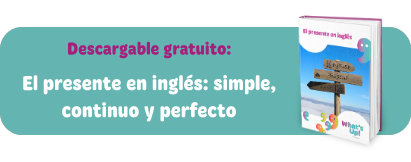What's Up! blog
el mejor contenido del mejor curso de inglés
Presente simple y continuo: ejercicios para repasar
El presente es el tiempo verbal más sencillo y más utilizado, y no suele llevar mucho tiempo aprendérselo, pero nunca está de más repasar un poco. Aunque ya lo tengas más o menos controlado, puede que repasando descubras alguna cosa que no tenías clara. Además, cuanto más practiques, menos probable será que se te olvide.
¿Presente simple o presente continuo?
Antes de empezar a hacer los ejercicios, repasemos brevemente cuándo se usa cada tiempo:
El presente simple es para actividades cotidianas o rutinas. Lo podemos usar para hablar de lo que hacemos mucho, de lo que hacemos poco o de lo que no hacemos, pero siempre con esta sensación de rutina:
- I brush my teeth three times a day. — Me lavo los dientes tres veces al día.
- We cycle to work every day. — Vamos en bicicleta a trabajar todos los días.
- She never drives in the city. — Nunca coge el coche por la ciudad.
También sirve para hablar del futuro, pero solo en este caso: actividades programadas con un horario concreto:
- Lectures start at 8 a.m. — Las clases empiezan a las 8 de la mañana.
- The train leaves at five. — El tren sale a las cinco.
- Breakfast is from eight to ten. — El desayuno es de ocho a diez.
Lo usamos también para describir circunstancias permanentes y con verbos de estado. ¡Cuidado! Hay verbos cuyo significado cambia si usas el presente continuo en vez del simple:
- Bruno works in the Marketing Department. — Bruno trabaja en el departamento de marketing.
- The Earth revolves around the Sun. — La tierra gira alrededor del sol.
- Wolves hunt in packs. — Los lobos cazan en manada.
El presente continuo es para actividades del momento, que están ocurriendo en este preciso instante o en este período de tiempo:
- He is brushing his teeth right now!. — Él se está lavando los dientes en este momento.
- We are riding our bicycles around the park. — Estamos montando en bici por el parque.
- She is driving a bright red car. — Está conduciendo un coche de color rojo vivo.
También sirve para planes fijos en el futuro:
- We are getting married on June 22. — Nos casamos el 22 de junio.
- She is travelling to India in a couple of weeks. — Se va a India en un par de semanas.
- They are moving this weekend. — Se mudan esta semana.
Lo usamos también para describir circunstancias temporales:
- Bruno is working in the Marketing Department while he finds something better. — Bruno está trabajando en el departamento de marketing mientras busca algo mejor.
- The red squirrel is disappearing from European forests. — La ardilla roja está desapareciendo de los bosques europeos.
- Young people are having trouble finding work . — Los jóvenes están teniendo problemas para encontrar trabajo.
Ejercicios
Elige el presente simple o el continuo para completar las siguientes frases:
- (You / come) ________________________________ tonight?
- (He / eat) ______________________________ rice every day?
- I (work) _____________________________ at the moment.
- (He / come) _________________________________ to London often?
- He (play) _________________________________ tennis now.
- (You / come) ________________________________ to the cinema later?
- They (not / come) ______________________________ to the party tomorrow.
- (You / play) _________________________________ tennis this Sunday?
- When (classes/start) _________________________?
Respuestas
- Are you coming tonight?
- Does he eat rice every day?
- I am working at the moment.
- Does he come to London often?
- He is playing tennis now.
- Are you coming to the cinema later?
- They aren’t coming to the party tomorrow.
- Are you playing tennis this Sunday?
- When do the classes start?
Posts relacionados:



